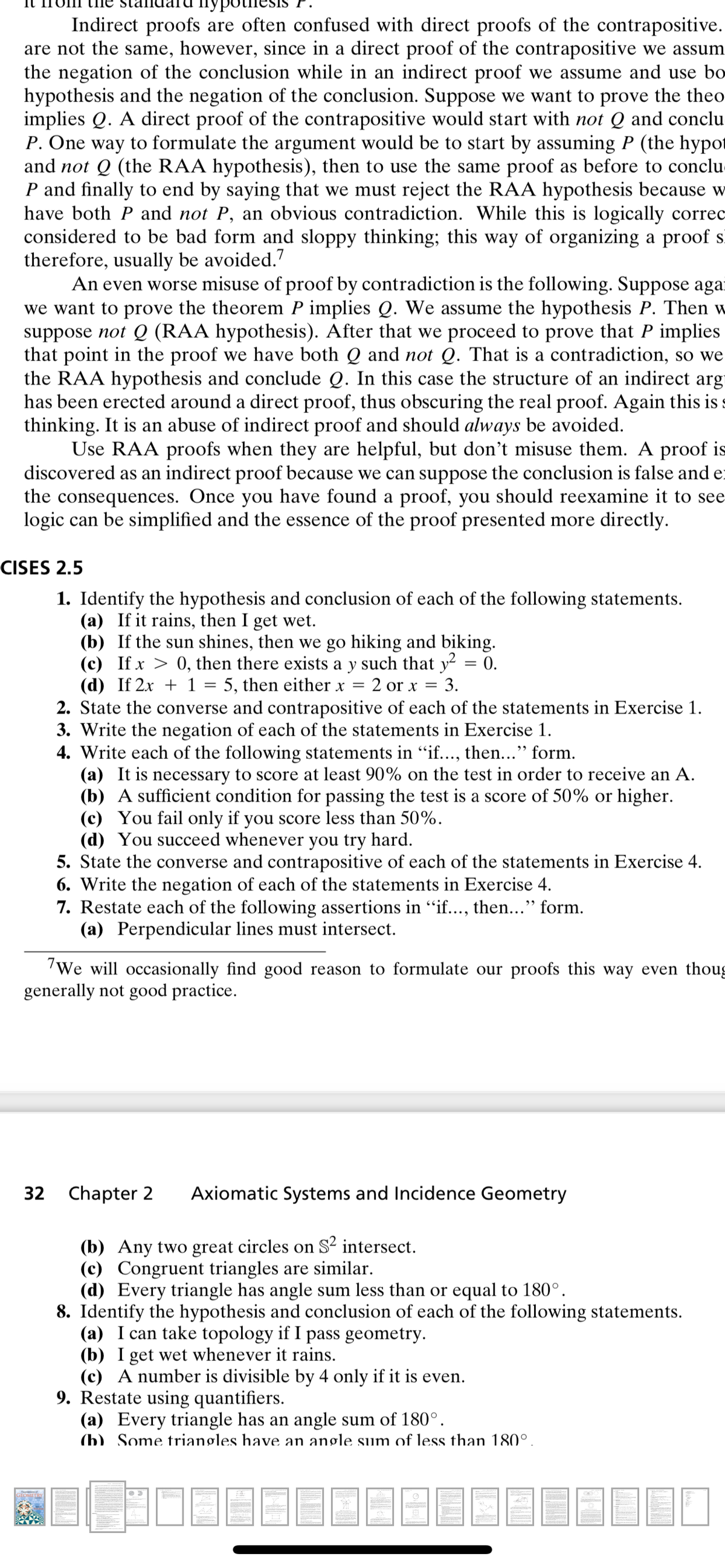1. Identify the hypothesis and conclusion of each of the following statements. (a) If it rains, then I get wet. (b) If the sun shines, then we go hiking and biking. (c) If x > 0, then there exists a y such that y = 0. (d) If 2x + 1 = 5, then either x = 2. State the converse and contrapositive of each of the statements in Exercise 1. 2 or x = 3.
1. Identify the hypothesis and conclusion of each of the following statements. (a) If it rains, then I get wet. (b) If the sun shines, then we go hiking and biking. (c) If x > 0, then there exists a y such that y = 0. (d) If 2x + 1 = 5, then either x = 2. State the converse and contrapositive of each of the statements in Exercise 1. 2 or x = 3.
Elementary Geometry For College Students, 7e
7th Edition
ISBN:9781337614085
Author:Alexander, Daniel C.; Koeberlein, Geralyn M.
Publisher:Alexander, Daniel C.; Koeberlein, Geralyn M.
Chapter2: Parallel Lines
Section2.CT: Test
Problem 3CT: To prove a theorem of the form "If P, then Q" by the indirect method, the first line of the proof...
Related questions
Question
Question 2 2.5

Transcribed Image Text:Indirect proofs are often confused with direct proofs of the contrapositive.
are not the same, however, since in a direct proof of the contrapositive we assum
the negation of the conclusion while in an indirect proof we assume and use bo
hypothesis and the negation of the conclusion. Suppose we want to prove the theo
implies Q. A direct proof of the contrapositive would start with not Q and conclu
P. One way to formulate the argument would be to start by assuming P (the hypot
and not Q (the RAA hypothesis), then to use the same proof as before to conclu
P and finally to end by saying that we must reject the RAA hypothesis because w
have both P and not P, an obvious contradiction. While this is logically correc
considered to be bad form and sloppy thinking; this way of organizing a proof sĩ
therefore, usually be avoided.7
An even worse misuse of proof by contradiction is the following. Suppose agar
we want to prove the theorem P implies Q. We assume the hypothesis P. Then w
suppose not Q (RAA hypothesis). After that we proceed to prove that P implies
that point in the proof we have both Q and not Q. That is a contradiction, so we
the RAA hypothesis and conclude Q. In this case the structure of an indirect arg
has been erected around a direct proof, thus obscuring the real proof. Again this is
thinking. It is an abuse of indirect proof and should always be avoided.
Use RAA proofs when they are helpful, but don't misuse them. A proof is
discovered as an indirect proof because we can suppose the conclusion is false and e
the consequences. Once you have found a proof, you should reexamine it to see
logic can be simplified and the essence of the proof presented more directly.
CISES 2.5
1. Identify the hypothesis and conclusion of each of the following statements.
(a) If it rains, then I get wet.
(b) If the sun shines, then we go hiking and biking.
(c) If x > 0, then there exists a y such that y² = 0.
(d) If 2x + 1 = 5, then either x
2. State the converse and contrapositive of each of the statements in Exercise 1.
3. Write the negation of each of the statements in Exercise 1.
4. Write each of the following statements in "if..., then..." form.
(a) It is necessary to score at least 90% on the test in order to receive an A.
(b) A sufficient condition for passing the test is a score of 50% or higher.
(c) You fail only if you score less than 50%.
(d) You succeed whenever you try hard.
5. State the converse and contrapositive of each of the statements in Exercise 4.
6. Write the negation of each of the statements in Exercise 4.
7. Restate each of the following assertions in "if..., then..." form.
(a) Perpendicular lines must intersect.
2 or x
3.
We will occasionally find good reason to formulate our proofs this way even thoug
generally
good practice.
32 Chapter 2
Axiomatic Systems and Incidence Geometry
(b) Any two great circles on S² intersect.
(c) Congruent triangles are similar.
(d) Every triangle has angle sum less than or equal to 180°.
8. Identify the hypothesis and conclusion of each of the following statements.
(a) I can take topology if I pass geometry.
(b) I get wet whenever it rains.
(c) A number is divisible by 4 only if it is even.
9. Restate using quantifiers.
(a) Every triangle has an angle sum of 180°.
(b) Some triangles have an angle sum of less than 180°.
Expert Solution
This question has been solved!
Explore an expertly crafted, step-by-step solution for a thorough understanding of key concepts.
This is a popular solution!
Trending now
This is a popular solution!
Step by step
Solved in 2 steps

Recommended textbooks for you

Elementary Geometry For College Students, 7e
Geometry
ISBN:
9781337614085
Author:
Alexander, Daniel C.; Koeberlein, Geralyn M.
Publisher:
Cengage,

Elementary Geometry for College Students
Geometry
ISBN:
9781285195698
Author:
Daniel C. Alexander, Geralyn M. Koeberlein
Publisher:
Cengage Learning

Elementary Geometry For College Students, 7e
Geometry
ISBN:
9781337614085
Author:
Alexander, Daniel C.; Koeberlein, Geralyn M.
Publisher:
Cengage,

Elementary Geometry for College Students
Geometry
ISBN:
9781285195698
Author:
Daniel C. Alexander, Geralyn M. Koeberlein
Publisher:
Cengage Learning